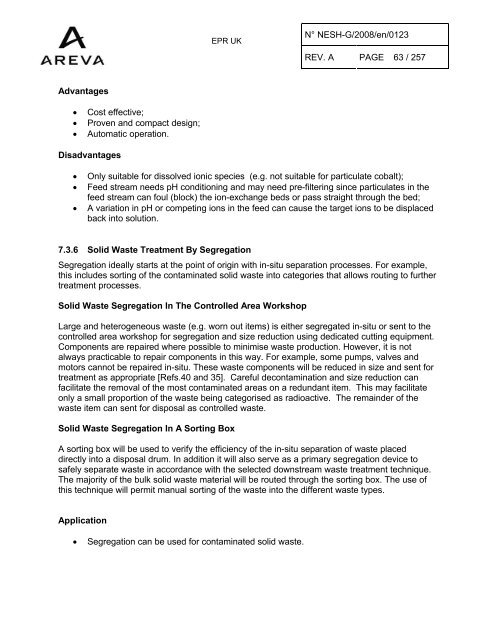Solid Radioactive Waste Strategy Report.pdf - UK EPR
Solid Radioactive Waste Strategy Report.pdf - UK EPR
Solid Radioactive Waste Strategy Report.pdf - UK EPR
Create successful ePaper yourself
Turn your PDF publications into a flip-book with our unique Google optimized e-Paper software.
<strong>EPR</strong> <strong>UK</strong><br />
N° NESH-G/2008/en/0123<br />
REV. A PAGE 63 / 257<br />
Advantages<br />
· Cost effective;<br />
· Proven and compact design;<br />
· Automatic operation.<br />
Disadvantages<br />
· Only suitable for dissolved ionic species (e.g. not suitable for particulate cobalt);<br />
· Feed stream needs pH conditioning and may need pre-filtering since particulates in the<br />
feed stream can foul (block) the ion-exchange beds or pass straight through the bed;<br />
· A variation in pH or competing ions in the feed can cause the target ions to be displaced<br />
back into solution.<br />
7.3.6 <strong>Solid</strong> <strong>Waste</strong> Treatment By Segregation<br />
Segregation ideally starts at the point of origin with in-situ separation processes. For example,<br />
this includes sorting of the contaminated solid waste into categories that allows routing to further<br />
treatment processes.<br />
<strong>Solid</strong> <strong>Waste</strong> Segregation In The Controlled Area Workshop<br />
Large and heterogeneous waste (e.g. worn out items) is either segregated in-situ or sent to the<br />
controlled area workshop for segregation and size reduction using dedicated cutting equipment.<br />
Components are repaired where possible to minimise waste production. However, it is not<br />
always practicable to repair components in this way. For example, some pumps, valves and<br />
motors cannot be repaired in-situ. These waste components will be reduced in size and sent for<br />
treatment as appropriate [Refs.40 and 35]. Careful decontamination and size reduction can<br />
facilitate the removal of the most contaminated areas on a redundant item. This may facilitate<br />
only a small proportion of the waste being categorised as radioactive. The remainder of the<br />
waste item can sent for disposal as controlled waste.<br />
<strong>Solid</strong> <strong>Waste</strong> Segregation In A Sorting Box<br />
A sorting box will be used to verify the efficiency of the in-situ separation of waste placed<br />
directly into a disposal drum. In addition it will also serve as a primary segregation device to<br />
safely separate waste in accordance with the selected downstream waste treatment technique.<br />
The majority of the bulk solid waste material will be routed through the sorting box. The use of<br />
this technique will permit manual sorting of the waste into the different waste types.<br />
Application<br />
· Segregation can be used for contaminated solid waste.

















